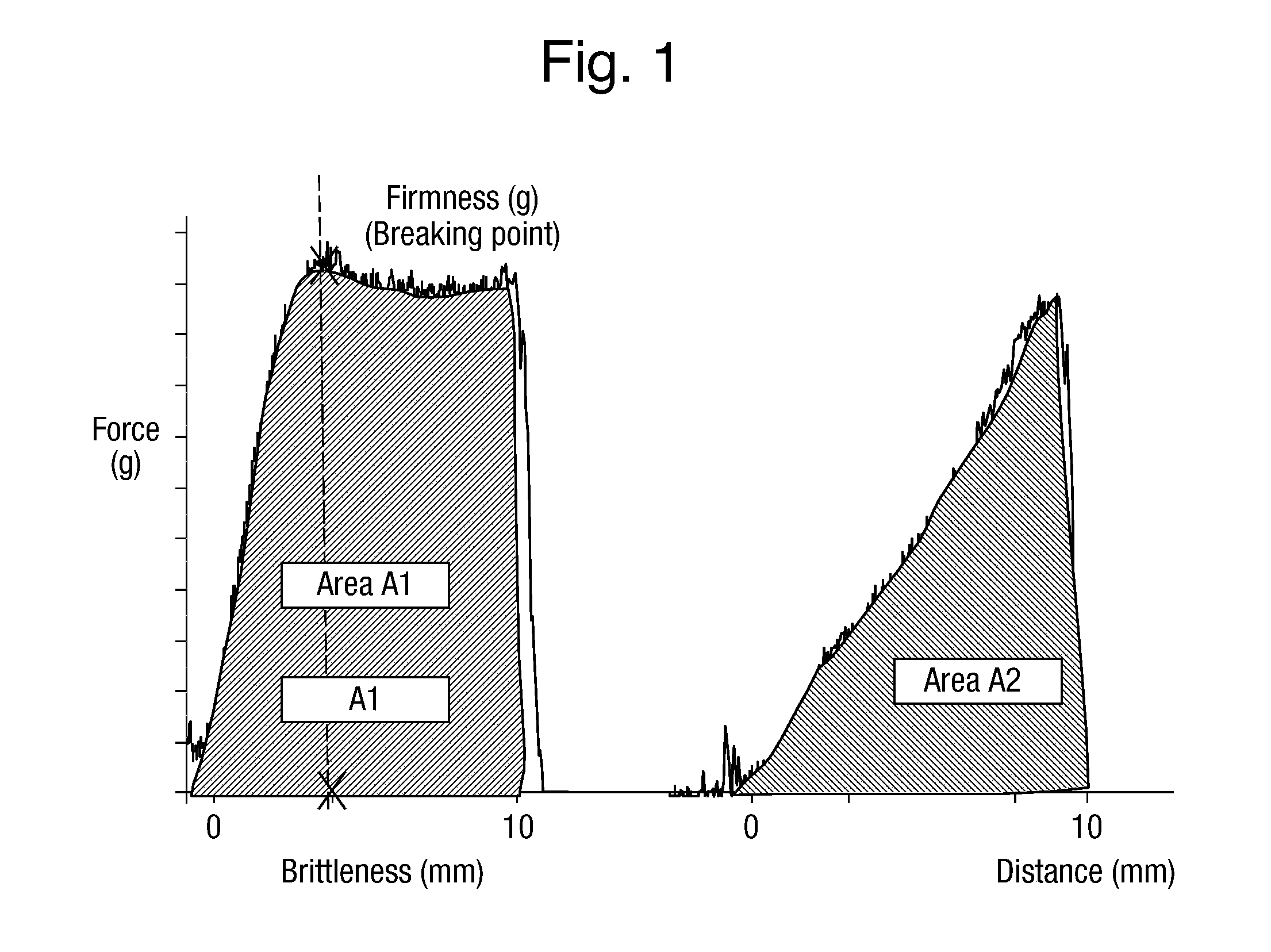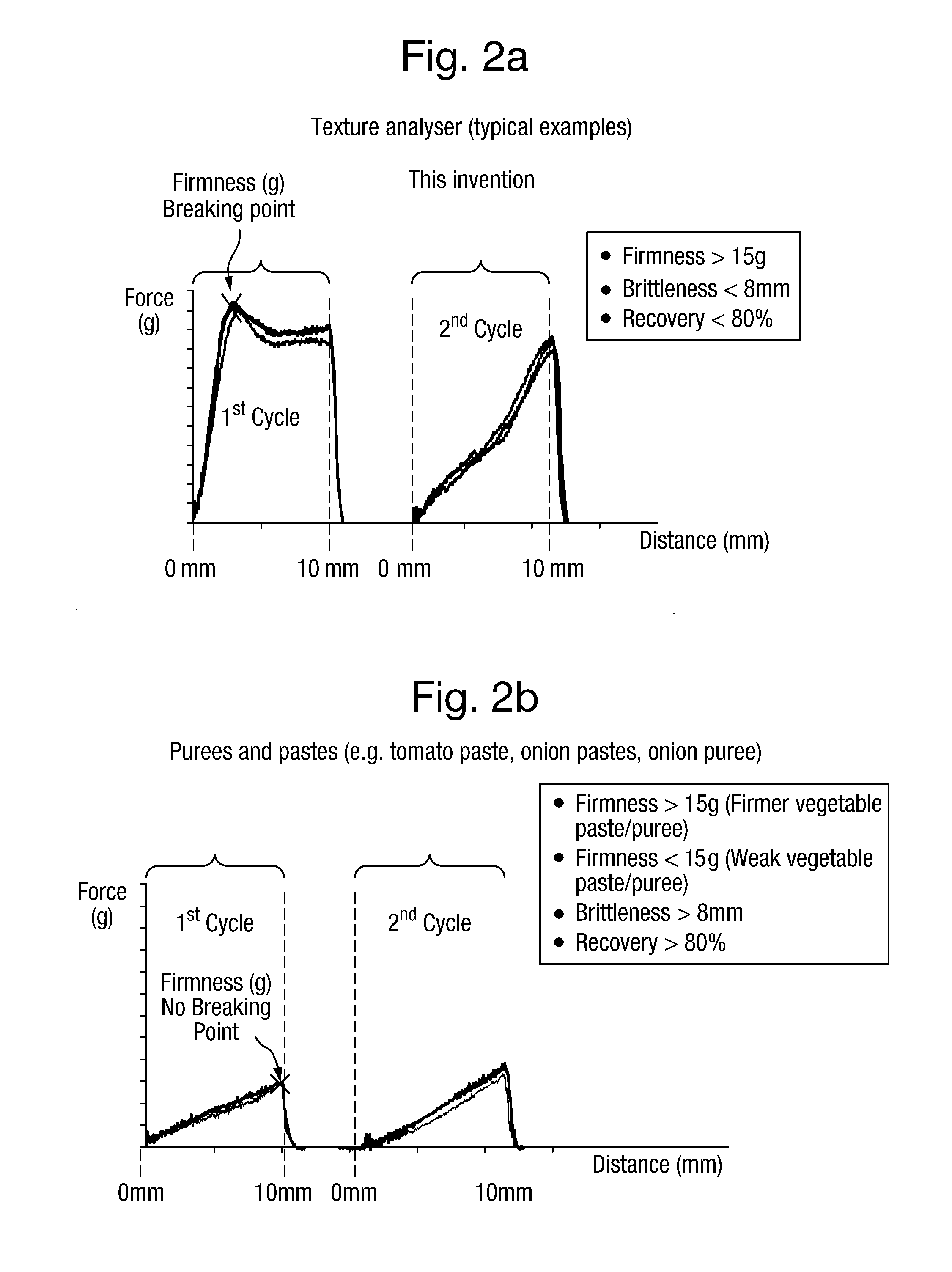Concentrate food composition in the form of a gel
a technology of food composition and gel, which is applied in the field of concentrated food composition in the form of gel, can solve the problems of inability to produce savoury high-salt gel at industrial scale, inability to meet the requirements of high-salt levels, etc., and achieves the effect of easy and natural spoonability
- Summary
- Abstract
- Description
- Claims
- Application Information
AI Technical Summary
Benefits of technology
Problems solved by technology
Method used
Image
Examples
example 1
[0178]A concentrate food composition was prepared according to the invention.
Preparation:
[0179]a) Products According to the Invention:[0180]1. Onions were peeled and cut in pieces of about 3 cm.[0181]2. The cut onions were heated by using a microwave oven to reach a temperature of above 95° C.[0182]3. The resulting heated onions were comminuted by using a kitchen blender[0183]4. An acidification step was carried out by lowering of the pH to 1.6 with 6M HCl. The pH was kept at 1.6 for 10 minutes at a temperature of 65 to 75° C., and was then adjusted to pH 4.1 using 6M NaOH.[0184]5. Fungal PME (PME Novoshape, Novozymes, Denmark) was added by mixing it into the comminuted onion and was allowed to incubate for 30 min at 50° C.[0185]6. NaCl was added and mixed into the comminuted onion (amounts as in tables 1b and 1c)[0186]7. The PME was inactivated by a heating step to above 80° C. using a microwave oven[0187]8. CaCl2.2H2O was added and mixed in[0188]9. The resulting product was hot-fi...
example 2
Gel Preparation with and without PME Treatment
[0212]A gel was prepared according to the invention. In addition a comparative example was prepared, without a PME treatment.[0213]1.1 kg of fresh onions was processed according to steps 1 to 4 as in Example 1a (comminuted and acidified) and this was split in 3 portions of 250 g[0214]a. To 250 g of the comminuted onion puree 0.3 g of PME (Novoshape, Novozymes, Denmark) was stirred in and kept at 50° C. for 60 min (sample 2a)[0215]b. To 250 g comminuted onion puree 0.015 g of PME (Novoshape, Novozymes, Denmark) was stirred in and kept at 50° C. for 60 min (sample 2b).[0216]c. To 250 g comminuted onion puree no PME was added (comparative sample 2c)[0217]2. To all portions (a-c) of comminuted onion puree (2a-2c) 15 wt % (on total product weight) of NaCl was added, respectively.[0218]3. The portions were heated in a microwave oven to achieve a temperature of above 80° C. to inactivate the added PME enzyme,[0219]4. Immediately thereafter 0.7 ...
example 3
[0225]1. Onions were peeled, cut in pieces of about 3 cm and immediately thereafter stored in air tight container at −20° C. until frozen (2 days).
Onion Jelly Preparation:
[0226]1. Frozen onions were heated in a microwave oven until a temperature was reached above 95° C.[0227]2. Steps 3 to 4 as in Example 1a (this invention) were followed[0228]3. The resulting comminuted onion was split into two portions: in one portion PME enzyme was not added and to the other 1 ml PME / kg of comminuted onion (Novoshape, Novozymes, Denmark) was added and kept incubating at 50° C. for 30 min.[0229]4. Pectin powder (Grindsted LC 810 from Danisco) and NaCl were added together with the Savoury mix to both comminuted onion purees in the amount as described as in table 3.[0230]5. The mixture was heated in a microwave oven to a temperature was reached of above 80° C.[0231]6. Immediately thereafter CaCl2.2H2O was added and mixed in[0232]7. The end product was hot filled in jars and stored at 5° C.
[0233]Analy...
PUM
 Login to View More
Login to View More Abstract
Description
Claims
Application Information
 Login to View More
Login to View More - R&D
- Intellectual Property
- Life Sciences
- Materials
- Tech Scout
- Unparalleled Data Quality
- Higher Quality Content
- 60% Fewer Hallucinations
Browse by: Latest US Patents, China's latest patents, Technical Efficacy Thesaurus, Application Domain, Technology Topic, Popular Technical Reports.
© 2025 PatSnap. All rights reserved.Legal|Privacy policy|Modern Slavery Act Transparency Statement|Sitemap|About US| Contact US: help@patsnap.com



